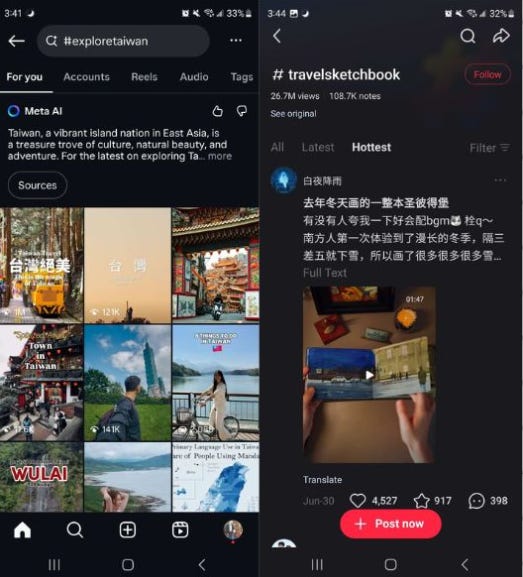One benefit of diversity is that it helps us come to a better understanding of the whole. Take, for example, the use of hashtags and artificial intelligence in app user experience.
Below is a screenshot of Instagram and Xiaohongshu (RedNote). I tapped on tourism-related hashtags on both of the apps.
What can we notice very quickly?
Instagram has incorporated an artificial intelligence chatbot. Xiaohongshu hasn't.
We must ask: what exact purpose does this chatbot serve? Has it been added just because that's the trend and Meta doesn't want to appear old-fashioned, or is there an actual strategic reason?
Without being able to look under the hood, the answer to this is unclear. As a user, I may not actually want to have a quarter of the screen resemble a mini-Wikipedia article. If I want to learn about basic facts about Taiwan, I could just open my Wikipedia app or search on Google. I guess some users may be interested in searching for information on Instagram. After all, TikTok has become a common search tool. Yet, what percent use Instagram for this?
Then think from a company's point of view. if a user taps a hashtag, would you rather the page that appears serve your business or not?
I recall hearing a few years ago from an account that helps others improve their fanbase on Instagram that hashtags are outdated. They recommended creators write sentences instead.
This is another example of assuming that the new is always better than the old.
Now, let's turn to Xiaohongshu. When I tap a hashtag, I am taken to another interface that shows me all related posts that have included it. Sometimes, we can even find a short description of the hashtag, similar to trending topics on X.
As a business, I may prefer the older-hashtag model as it offers another tool to initiate marketing campaigns.
The best apps are like people. They know themselves and their audience. They don't follow the crowd. They learn how it breathes.
Discussion about this post
No posts




